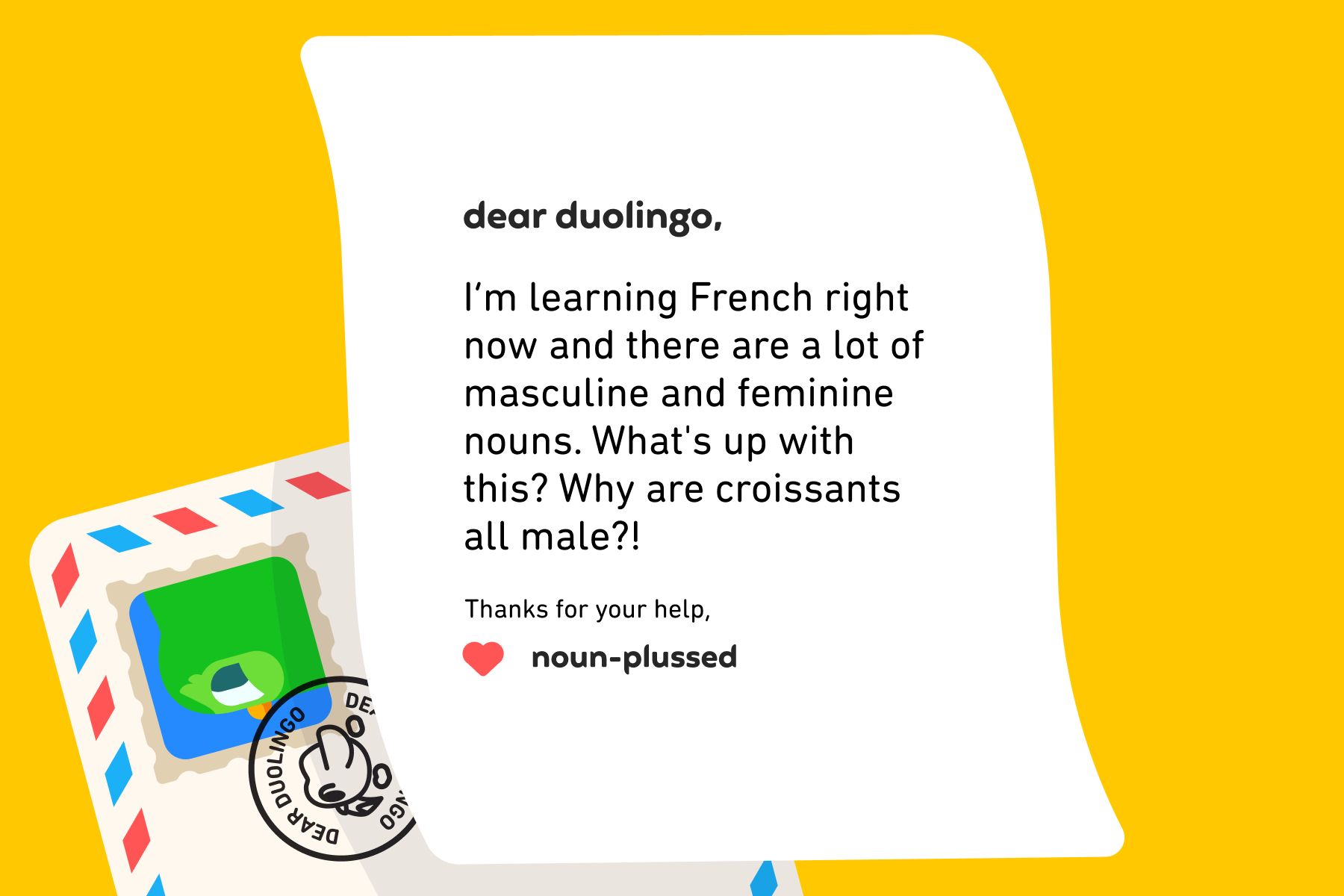Welcome to another week of Dear Duolingo, an advice column just for language learners. Catch up on past installments here.
Hello again, learners! Remember how I promised you a part two on grammatical gender? This is that part two! Let’s remind ourselves of the original question:

Last time on Dear Duolingo we dug into grammatical gender, a system of noun categories. We talked a lot about how these categories, and whether a word is masculine or feminine, is unrelated to meaning. That means if you're a language learner, you won't be able to analyze the meaning of a noun and decide which category it belongs to. But, Noun-Plussed, there is good news: there are often other patterns you can look for!
Differences in grammatical gender systems
Even among European languages, there can be big differences in how grammatical gender works.
How many categories are there?
Most European languages have either two grammatical gender categories (masculine and feminine) or three categories. The third category, called "neuter," just basically means "not feminine or masculine." It can include animate nouns for people (even if the person being referred to is a man or a woman), and will certainly include lots of inanimate nouns. And as we mentioned in the previous post about gender, there are lots of other ways languages, including European languages, categorize nouns. (We're looking at you, Dutch, Swedish, and all you languages where the two genders are "common" and "neuter.")
Some of the two-gender languages you'll run across are Catalan, French, Italian, and Spanish – and Arabic, which is a Semitic language (from a different language family entirely!). If you're studying German, Romanian, Russian, or Ukrainian, you'll be learning a language with three grammatical gender categories.
What words have to match the noun?
At its core, grammatical gender is a matching system: each noun belongs to some category, and when that noun is used in a sentence, words that are linked to it (like adjectives) have to be from the same category. As with everything, the devil is in the details: languages differ in terms of which words count as "linked" to the noun.
In both Spanish and Russian, for example, adjectives have to match the gender of the noun, but these languages treat verbs differently. In Spanish, verbs don't match the gender of the noun, but in Russian, past tense verbs do match the noun's gender. Check out which words do or don’t change for gender depending on the language!
| Spanish | Russian | |
|---|---|---|
| Adjectives | El carro es rojo. [The noun "carro" is masculine] The car is red. La mesa es roja. [The noun "mesa" is feminine] The table is red. |
Машина красная. Mashina krasnaya. [The noun "mashina" is feminine] The car is red. Стол красный. Stol krasnyĭ. [The noun "stol" is masculine] The table is red. |
| Verbs | El carro estaba aquí. The car was here. La mesa estaba aquí. The table was here. [Notice how the verb doesn’t change!] |
Машина была здесь. Mashina byla zdes'. The car was here. Стол был здесь. Stol byl zdes'. The table was here. |
Did you see in the table above how the Spanish and Russian words for table and car also have a different gender in each language? That's because, as we remember, grammatical gender categories aren't about the word's meaning.

How to learn and practice grammatical gender
Now that you know how grammatical gender works in the language you're learning, here are some ideas for how to remember the gender of nouns:
- Study the noun and gender together. If you make flashcards, write out the word with a word that makes its gender clear. So instead of learning the Spanish word casa alone, write out la casa (with the feminine la). (In fact, this is how babies learn these languages – they learn chunks like lacasa and later learn that it's la + casa!) You could also use a phrase to make it clear, like la casa roja, so that there are multiple hints about the gender of the noun (the feminine la and the feminine roja). Be sure to pick words that have easy, clear clues – for example, azul (the Spanish word for "blue") is the same for masculine and feminine, so it won't help you remember gender! This will be especially important in French, where many masculine and feminine forms sound the same.
- Reading practice helps you get used to the word's gender. Reading – whether it's books, Instagram posts, or Reddit – helps you to see nouns in use along with any words that have to match them in gender. You'll always run into exceptions to the many rules about which words are in which category, so reading is a great way to get lots of input – language you can learn from!
- Focus on meaning, and don't worry too much about gender. There are relatively few cases where using the wrong gender changes the meaning or keeps you from being understood, so it's ok to make mistakes! Communicating is the most important part of learning a new language. There are worse things than mixing up der Kiwi (German for the Kiwi bird, which is masculine) with die Kiwi (German for the kiwi fruit, which is feminine). See below for a few examples that show how different the meaning is when you change the word's grammatical gender!
And even though there aren't tons of examples where changing the noun category totally changes the meaning, it's always fun to see how different meanings can be! 😉
French
| Meaning when masculine | Meaning when feminine | |
|---|---|---|
| livre | book | pound, like weight or currency |
| tour | tour | tower |
| mode | setting/mode | fashion |
Portuguese
| Meaning when masculine | Meaning when feminine | |
|---|---|---|
| cara | guy | face |
| rádio | radio | radio station |
| grama | gram, like the measurement | grass |
Spanish
| Meaning when masculine | Meaning when feminine | |
|---|---|---|
| papa | Pope | potato |
| guía | guide, like a person who gives tours | guidebook |
| frente | front part of something | forehead |

Grammatical gender patterns in different languages
Ok, ok – I've told you a hundred times that you typically can't use a noun's meaning to know which category it's in. But there are other patterns you can use to help learn a noun's gender: in many languages, a word's ending can help you guess its grammatical gender category.
That's because many words have inherited their grammatical gender from earlier stages of the language, and earlier stages might have had a totally different noun category system. That's the case for Romance languages, which today have a much simpler system than Latin's rules for nouns, which combined grammatical gender with declensions and cases (two additional category systems I'm dying to write about).
In the next sections we'll show you the most important patterns in a few languages, but these are far from the whole story. These rules will cover the most common cases you'll encounter!
Jump to rules for:
Arabic
French
German
Portuguese
Russian
Spanish
Ukrainian
Tips for grammatical gender in Spanish and Portuguese
Spanish and Portuguese are closely related Romance languages, so they share a lot of gender category patterns. Not all words will have the same gender in both languages, but these shared rules cover a lot of ground.
- Words for people will have the same grammatical gender as their meaning, and words for professions often change to match the person.
- Spanish: el hombre (the man), el artista (the male artist), la mujer (the woman), la artista (the female artist)
- Portuguese: o príncipe (the prince), o dentista (the male dentist), a princesa (the princess), a dentista (the female dentist)
- Most words that end with -o are masculine, and most that end with -a are feminine.
- Spanish: el libro (the book), el oro (the gold), la mesa (the table), la lechuga (the lettuce)
- Portuguese: o carro (the car), o tijolo (the brick), a folha (the leaf), a rua (the street)
After those two basic rules, the best thing you can do is look at the last syllable. In many cases, looking at the last few letters will be more helpful than looking at just the last one alone.
- Words with -ama and -ema are mostly masculine. (They come from Greek!)
- Spanish: el programa (the program), el tema (the theme/topic)
- Portuguese: o quilograma (the kilogram), o problema (the problem)
- Words with the Spanish -ción and -sión or the Portuguese -ção and -são are mostly feminine. Note that looking at the last syllable leaves out el avión and o avião (the airplane), which is masculine!
- Spanish: la acción (the action), la televisión (the television)
- Portuguese: a emoção (the emotion), a visão (the vision). Look out for exceptions in Portuguese, like o coração (the heart) and o calção (the shorts).
- Words with Spanish -dad and Portuguese -dade are mostly feminine.
- Spanish: la edad (the age), la igualdad (the equality)
- Portuguese: a cidade (the city), a nacionalidade (the nationality)
- Look out for some common words that are exceptions to the rule. These ones you'll have to truly memorize. For example, in Spanish la mano (hand), la foto (photograph), and la moto are all feminine. It might help to remember that la foto is short for la fotografía and la moto for la motocicleta!
Here are some interesting nuggets about grammatical gender in Spanish and Portuguese:
- Speakers of Brazilian Portuguese started to use a presidenta more than a presidente when Dilma Rousseff was elected the first woman president in Brazil. However, the term has been in dictionaries for over a century!
- In Spanish, feminine words that start with a stressed a-, like águila (eagle), agua (water), and arte (art) use the masculine el when the noun is singular. Confusing, right? It's because using la would leave two stressed (emphasized) a sounds in a row (la + agua), and Spanish prefers to break that up and just use el instead. (This is like how in English we prefer to say an apple instead of a apple to break up the a sounds) So in Spanish it's el agua for "the water" but las aguas for "the waters,” because in the plural, the "s" in las breaks up the two a sounds!
- In both languages, compound words that start with a verb are masculine, no matter the word's ending. So Spanish lavaplatos (dishwasher – literally, the wash-dishes) and Portuguese guarda-chuva (umbrella – literally, the guard-from-rain) are masculine: el lavaplatos and o guarda-chuva.
Tips for grammatical gender in Russian and Ukrainian
As you might know, Russian and Ukrainian are also distantly related, sort of like Spanish and Portuguese. These languages also have a lot in common when it comes to which words are in which grammatical gender category! But unlike Spanish and Portuguese, Russian and Ukrainian have three categories: masculine, feminine, and neuter.
The other difference between Russian and Ukrainian versus Spanish and Portuguese, is that you only need a few rules. Here they are:
- Words ending with hard consonants are generally masculine.
- Russian: стол (stol; "table"), карандаш (karandash; "pencil")
- Ukrainian: паспорт (pasport; "passport"), дім (dim; "house")
- Words ending with the vowels а (a) or я (ya) in either language are generally feminine – unless the word refers to a human man, like Russian папа (papa; "dad") is masculine.
- Russian: книга (kniga; "book"), машина (mashina; "car")
- Ukrainian: кава (kava; "coffee"), історія (istoriia; "history")
- Words ending with the vowels о, ё (yo), or е in Russian or o and е in Ukrainian are generally neuter.
- Russian: солнце (solntse; "sun"), дерево (derevo; "tree")
- Ukrainian: місто (misto; "city"), вікно (vikno; "window")
-
Russian exceptions: Words ending with soft consonants in Russian can be either masculine or feminine, so these are the (relatively few) words you'll have to memorize!
-
Ukrainian exceptions: There are exceptions to the rules, of course. For example, волосся (volossia; "hair") is neuter despite the typically feminine ending of я, and тато (tato; "dad") is masculine despite the о.
Tips for grammatical gender in French
For French learners, unfortunately, there isn’t a great main rule like the -o/-a endings in Spanish, but there are some patterns you can look for – including some patterns related to meaning (!).
- Words for people will have the same grammatical gender as their meaning, and words for professions will change to match the person.
- Masculine: le responsable (the male manager), le touriste (the male tourist)
- Feminine: la responsable (the female manager), la touriste (the female tourist)
- For inanimate nouns (nouns that aren't people or animals), look for clues in their ending. There will be excpetions to look out for, but these general patterns will get you pretty far!
- Masculine endings: -al, -eau, et, and ier. (Exceptions include l'eau "the water," which is feminine.)
- Feminine endings: -e (no accent mark), including -ade, -ale, -ette, -ille, -oire, -sion, and -tion. (Exceptions include -acle, -age, and -isme, which tend to be masculine.)
- There are some groups of words that have a predictable grammatical gender, no matter their ending!
- Days and months are masculine: le lundi (Monday), le mardi (Tuesday), le dimanche (Sunday)
- Seasons are masculine: un décembre froid (a cold December), un été chaud (a hot summer)
- Languages are masculine: le français (French), le russe (Russian)
Tips for grammatical gender in Arabic
-
Unlike the other languages discussed in this post, which are in the group of languages called Indo-European, Arabic is a Semitic language, and it also has the grammatical gender categories masculine and feminine. In many ways, knowing the gender category of a noun is much easier in Arabic than in the European languages we've discussed.
-
Words for people and animals will generally have the grammatical gender that matches their natural gender, and many of these words can simply get the feminine ending to represent women and female animals.
- Masculine: طبيب (tabiib; "male doctor"), قط (qet; "male cat")
- Feminine: طبيبة (tabiiba; "female doctor"), قطة (qeta; "female cat")
- For words for inanimate nouns (everything except animals and people), look at the word's ending to know which category it belongs to! The vast majority of feminine nouns take one of these three endings, while the vast majority of masculine nouns don't.
- Masculine: everything that's not those three feminine endings 🙌
- Feminine: ا (aa), ى (aa), ة (a/at)
There are some exceptions to that useful rule in #2.
- Some masculine nouns have the (typically) feminine ending ة (a/at), like خليفة ("caliph"), قادة ("leaders").
- Some feminine nouns take none of the three feminine endings listed above, like شمس ("sun"), حرب ("war"), and body parts that usually come in pairs like عين ("eye") and يد ("hand").
And, well, that's it!
Since now you've learned basically all the gender rules for Arabic, you can get to learning some interesting facts about grammatical gender in Arabic:
- For some animals, the word is either always masculine or always feminine. If the word is always feminine and you need to talk about a male, you add the word ذكر (dhakar) "male" before it. For example, the word for owl is بومة (boma), which is feminine, and to talk about a male owl, you'd say ذكر البوم (dhakar 2lbuum) – that's "male owl." That means any time you see ذكر, you can be certain that the noun is now masculine!
- The little tiny letter ة (a/at) at the end of most feminine words actually has a lot more going on behind the scenes. It's also used to "individuate" nouns referring to groups of things, like olives زيتون (zaytuun). Adding the ة ending makes the word refer to just one of them – an olive, زيتونة (zaytuuna)! The ة is also the last sound in the Levantine Arabic word for "guy", زلمة, which also shows that there's a lot more going on with this ة ending than just grammatical gender!
Tips for grammatical gender in German
Oh dear. You've come here looking for tips for German. Maybe you're learning German and have a lot of questions – since German has three grammatical gender categories, and a case system, and no apparent correspondence between endings and categories, and the only words there to help you figure out gender actually have multiple uses (die, das, etc).
We're going to dedicate an entire Dear Duolingo post to helping you, German learner. Stay tuned. (Also, maybe don't spend too much time looking at the lovely lists of rules and patterns for these other languages, ok? Definitely don't read about Arabic.)
Look for patterns, and then get communicating!
When it comes to grammatical gender, look for patterns in word endings! It's easy to get caught up in the details of grammar (and then buy an etymology dictionary, and switch your major to linguistics, and get a PhD in language…), but don't forget that grammar is just in service of communication. Let grammatical gender be an endearing oddity of the language you're learning!
And keep sending us your language questions and ideas for posts at dearduolingo@duolingo.com! We'll be back next week with another column about language learning. 🤓
Thanks to our teaching and translation experts who provided the rules for this post: Dr. Hope Wilson, Mykhaylo Zakryzhevskyy, Dr. Sharon Wilkinson, Dr. Emilie Zuniga, Lucimary Gama, Kristina Shoen, and Annina Pfennig.



